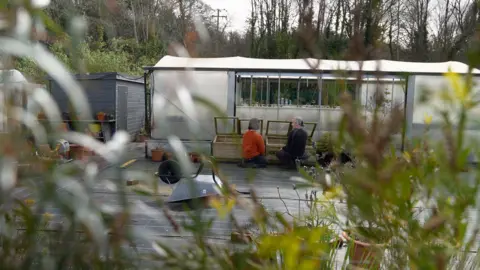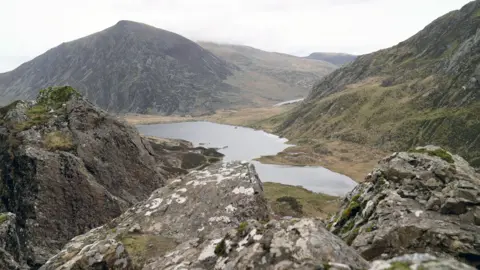Georgina Rannard,BBC climate and science reporter
 BBC/Gwyndaf Hughes
BBC/Gwyndaf HughesA plant that went extinct in the wild has been re-introduced to the UK mainland. We can’t tell you the exact location – it’s a secret, to keep it safe. It’s just one small plant but with one in six species in the UK endangered, you’ve got to start somewhere. We were there the moment pioneering horticulturist Robbie Blackhall-Miles returned it to its native soil.
I first met Robbie at his nursery for threatened plants – tucked away in a quiet part of North Wales.
What he keeps there is so valuable, he can’t even get it insured.
He asks me to be careful how much we reveal – there is still a lucrative market for rare and special plants, often picked illegally, often fetching thousands of pounds.
“There’s only 30 of those trees left in the world,” he says, pointing at a pot.
 BBC/Gwyndaf Hughes
BBC/Gwyndaf HughesAround us are trays of seedlings, bags of soil on the floor, plants growing and flowering. Thermometers hang from the roof to check the plants don’t get too hot, too cold or too dry.
Robbie is tall and athletic, he talks excitedly. When I started researching this story, Robbie’s name kept popping up in the records of botanical societies – there are few people in Britain who know as much about plants.
 BBC/Gwyndaf Hughes
BBC/Gwyndaf HughesHe got into botany after wanting to save animals as a child and a brief spell as a model. Now he’s working for Plantlife, a conservation charity.
“If you think about British biodiversity like a jigsaw puzzle – all the pieces are really important, but some are missing,” he says.
His goal, working with the National Trust and Natural Resource Wales, is to restore some of that biodiversity by re-introducing the extinct rosy saxifrage – a plant he calls a mountain jewel – to Eryri or Snowdonia.
 BBC/Gywndaf Hughes
BBC/Gywndaf HughesThe last time the rosy saxifrage was seen in the wild in the UK was in 1962, somewhere in the Cwm Idwal nature reserve in Eryri.
I wanted to see the place – so Robbie and National Trust ranger Rhys Weldon-Roberts took me and my colleague to Cwm Idawl.
We hiked a snaking path around the lake to a place called Tyll Du or, ominously in English, Devil’s Kitchen.
Robbie stopped every few steps to point out rare plants that have managed to survive.
By chance, I had walked here before. Struggling to climb up a crevice between the mountains, I had been totally oblivious to the precious species living under the boulders.
 BBC/Gwyndaf Hughes
BBC/Gwyndaf HughesThe rosy saxifrage is listed as extinct but Robbie, a skilled climber, still double-checked. “I’ve been up there on ropes, looking for it for six summers, just in case we were wrong,” he says, pointing up at sheer cliff faces.
“The rosy saxifrage is about as a native as you can get in the UK,” Robbie says, perched on a rock looking serenely out on this dramatic landscape.
It is part of a family of mountain plants that thrived when northern Britain was frozen over during the Ice Age. When the glaciers melted, the saxifrages stayed, thriving in the mountain environment.
But their delicate appearance and beautiful flowers eventually made them a magnet for plant collectors – particularly Victorians who picked them for private collections.
Then habitat loss and poorly managed grazing in Eryri were the final death knell for the plant.
Numbers fell dramatically, until it was gone from the UK mainland.
The next part of the story has the quality of folklore – in 1962 a teacher and conservationist called Dick Roberts was in Cwm Idawl on a school trip.
He picked up a piece of a plant that had washed down a path, and put it in his pocket. Unsure of what it was, he took it home and grew it in his garden.
All the rosy saxifrage now in the UK mainland goes back to that tiny plant – it saved the plant for future generations. About a decade ago Robbie was given a cutting to care for.
“I feel quite humbled to be working with part of Dick Roberts’ legacy,” he says.
 BBC/Gwyndaf Hughes
BBC/Gwyndaf HughesIt’s very unusual to be able to re-introduce a species with the genetic descendent of the native species.
Most of the time, related species are used, for example the European beaver was used to bring back beavers to the UK.
But Robbie says, holding it in his hands: “This is from cuttings of cuttings of cuttings of that original Welsh material.”
In the decades since Dick Roberts was in Eryri, nature in the UK has transformed dramatically.
One in six species are threatened with extinction. We have lost 19% of monitored species in the last 30-40 years, turning the UK into one of the most nature-depleted countries on Earth.
I invited Julia Jones, a professor of conservation at Bangor university, to Cwm Idwal to ask her how much difference bringing back this one small plant can make.
The truth is that alone it won’t transform UK nature – conservation is hugely complicated and needs lots of different work, including protecting habitats from climate change, pollution and intensive land use.
But Prof Jones says that this re-introduction acts as a flagship and “a reminder of just how much we have lost”.
High-profile plant re-introductions are rare – most work goes into bringing back animals. The most famous in the UK is probably the beaver or the white-tailed sea eagle – charismatic species that generally get people more excited than plants.
Some scientists talk about “plant blindness” – the idea that people don’t see plants around them as important living things – instead, they’re more like wallpaper in our natural environment, despite everything they do for our eco-systems and their role in producing medicine.
 BBC/Gwyndaf Hughes
BBC/Gwyndaf HughesFinally, a few days ago, the moment came that was ten years in the making.
At a secret location in Eryri, a few people assembled in the rain, including ranger Rhys Weldon-Roberts. He will be keeping a watchful eye on the plant, wary of collectors.
“Hopefully the day comes when this is no longer rare and everyone who visits will be able to appreciate it,” he says.
For Robbie Blackhall-Miles, who will continue to monitor the saxifrage, this is a big moment.
After 60 years in cultivation, will it survive outside?
He carries crates of the plant from his car.
It’s transformed since I last saw it – long stems extending from the dense leaves, leading to a white flower with five petals.
“I love these flowers – they shine up at you,” Robbie says.
After stepping through a river, Robbie crouches down, and peels away springy grass and soil. Digging, he hits rock: “That’s OK – in Latin saxifrage means rock-breaker.”
A few minutes later, the small mountain jewels are back in their native soil.
Robbie is visibly emotional. It is the high point of his career to re-introduce something into his own country, in a landscape he loves.
“In Welsh, we have a wonderful word adferiad, which means restitution or restoration,” he continues. “I’m absolutely over the moon.”
Additional reporting by Gwyndaf Hughes


